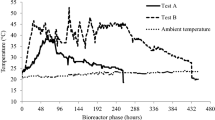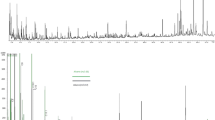Abstract
The aim of this work was to determine changes in bitumen content and fatty acid composition during 180 days of composting of municipal solid waste. Bitumen was extracted with ethanol and benzene mixture (1:2), while fatty acids were extracted with petroleum ether and identified in gas chromatography. Bitumen carbon and fatty acid carbon were calculated as a difference of organic carbon before and after the extraction. The results indicated that the content of bitumen decreases threefold stronger than other components. During thermophilic phase of composting of municipal solid waste, the total content of bitumen is able to decrease about fivefold, while fatty acid content can decrease about tenfold. Unsaturated fatty acids are more intensively decomposed during the composting process, while saturated fatty acids are more resistant.
Access provided by Autonomous University of Puebla. Download conference paper PDF
Similar content being viewed by others
Keywords
Introduction
Composting is one of the most reasonable way of municipal solid waste utilization, due to generation of material successfully used to improve soil properties and productivity (Weber et al. 2007). Raw materials, as well as mature composts, contain lipid substances, which are hydrophobic and considered as relatively resistant to microbiological transformation. Their decomposition and transformation may differ significantly, depending on temperature, pH and other parameters of composting process. The aim of this chapter was to determine changes in bitumen content and fatty acid composition during composting process of municipal solid waste.
Materials and Methods
Raw, non-selectively collected material was composted for 180 days in the pile in Katowice composting plant (Upper Silesia, Poland), after initial biostabilization according to MUT-DANO technology. Changes of temperature were measured each day through the whole composting process. Moisture, pH and total content of organic carbon (TOC) were determined in samples taken after 1, 14, 28, 42, 56, 90 and 180 days of composting. Bitumen was extracted with ethanol and benzene mixture (1:2), and bitumen carbon (CBIT) was calculated as a difference of organic carbon before and after the extraction, determined with Ströhlein CS-MAT 5500 analyzer. Fatty acids were extracted with petroleum ether, and fatty acid carbon (CFAT) was calculated analogous as for bitumen. Fatty acids were identified in gas chromatography (GC Agilent Technologies 6890N), after catalyzed transesterification with BF3 in methanol, according to Metcalfe et al. (1961).
Results and Discussion
The composted material was not regularly converted in a pile, and as a consequence, the thermophilic phase of the process took place within about 60 days (Fig. 1).
During 180 days of composting, due to decomposition of organic matter, the total carbon content decreased from about 200 g kg−1 to nearly 100 g kg−1 (Table 1).
The highest intensity of TOC decrease was observed until the 60th day of the composting, which corresponds to thermophilic phase. The content of bitumen decreased from 27.8 to 5.8 g kg−1 (Table 1) during first 90 days of composting. After that time, it remained on the same level due to cooling and stabilization of composting material in mesophilic phase (Chefetz et al. 1996). More intensive changes were observed in fatty acid content, which decreased from 2.0 to 0.1 g kg−1 during 90 days. After that period, the content of fatty acids slightly increases due to stabilization and changes of microbe composition (Ryckeboer et al. 2003; Amir et al. 2008). In that phase, fungus, actinomycetes and mesophilic cellulolytic bacteria dominate, which are unable to biotransform fatty acids; however, they are capable to synthesize them.
During the whole experiment, 24 fatty acids were identified, from which 14 were present only in trace amounts (Fig. 2). Because of that, only 10 fatty acids (6 saturated and 4 unsaturated) were selected for detailed investigations. Unsaturated fatty acids dominated in a raw material (Table 1). Octadecenoic acid (18:1) was the main unsaturated fatty acid, reaching 56% of CFAT in a raw material, decreasing to 23% CFAT after 180 days of composting (Table 2). This change corresponds to decreasing number of microorganisms during compost maturation (Hachicha et al. 2009) because octadecenoic acid is the main component of almost all cellular membranes occurring in living microorganisms.
At the final stage of the composting, fatty acids were dominated by saturated forms, mainly hexadecanoic (16:0) acid. The share of this component in CFAT increased from 18.8% at the beginning of the experiment up to 36.7% after 180 days (Table 3).
Moreover, the share of pentadecanoic (15:0) and heptadecanoic (17:0) fatty acids increased in CFAT during composting. These very specific fatty acids, with odd numbers of carbon in chain, are likely to be the result of bacterial biosynthesis (Gea et al. 2007). Similar changes were observed in share of octadecanoic (18:0), eicosanoic (20:0) and docosanoic (22:0) acids.
Since the total amount of fatty acids clearly decreased during the composting, an increased share of saturated fatty acids is a result of their bigger resistance to decomposition than unsaturated fatty acids.
Conclusions
-
1.
The extent of decomposition of bitumen and fatty acids is bigger than other components of composted municipal solid waste.
-
2.
During thermophilic phase of composting of municipal solid waste, the total content of bitumen is able to decrease about fivefold, while fatty acid content can decrease about tenfold.
-
3.
Unsaturated fatty acids are more intensively decomposed during the composting process, while saturated fatty acids are more resistant.
References
Amir, S., G. Merlina, E. Pinelli, P. Winterton, J.C. Revel, and M. Hafidi. 2008. Microbial community dynamics during composting of sewage sludge and straw studied through phospholipid and neutral lipid analysis. Journal of Hazardous Materials 159: 593–601.
Chefetz, B., P.G. Thatcher, Y. Hadar, and Y. Chen. 1996. Chemical and biological characterization of organic matter during composting of municipal solid waste. Journal of Environmental Quality 25: 776–785.
Gea, T., P. Ferrer, G. Alvaro, F. Valero, A. Artola, and A. Sanchez. 2007. Co-composting of sewage sludge: Fats mixtures and characteristics of the lipases involved. Biochemical Engineering Journal 33: 275–283.
Hachicha, R., S. Hachicha, I. Trabelsi, S. Woodward, and T. Mechichi. 2009. Evolution of the fatty fraction during co-composting of olive oil industry wastes with animal manure: Maturity assessment of the end product. Chemosphere 75: 1382–1386.
Metcalfe, L.D., and A.A. Schmitz. 1961. The rapid preparation of fatty acid esters for gas chromatographic analysis. Analytical Chemistry 33: 363–364.
Ryckeboer, J., J. Mergaert, J. Coosemans, K. Deprins, and J. Swings. 2003. Microbiological aspects of biowaste during composting in a monitored compost bin. Journal of Applied Microbiology 94: 127–137.
Weber, J., A. Karczewska, J. Drozd, M. Licznar, S. Licznar, E. Jamroz, and A. Kocowicz. 2007. Agricultural and ecological aspects of a sandy soil as affected by the application of municipal solid waste composts. Soil Biology and Biochemistry 39(6): 1294–1300.
Author information
Authors and Affiliations
Corresponding author
Editor information
Editors and Affiliations
Rights and permissions
Copyright information
© 2013 Zhejiang University Press and Springer Science+Business Media Dordrecht
About this paper
Cite this paper
Bekier, J., Drozd, J., Weber, J., Jarosz, B., Jamroz, E. (2013). Changes in Selected Hydrophobic Components During Composting of Municipal Solid Waste. In: Xu, J., Wu, J., He, Y. (eds) Functions of Natural Organic Matter in Changing Environment. Springer, Dordrecht. https://doi.org/10.1007/978-94-007-5634-2_56
Download citation
DOI: https://doi.org/10.1007/978-94-007-5634-2_56
Published:
Publisher Name: Springer, Dordrecht
Print ISBN: 978-94-007-5633-5
Online ISBN: 978-94-007-5634-2
eBook Packages: Earth and Environmental ScienceEarth and Environmental Science (R0)






